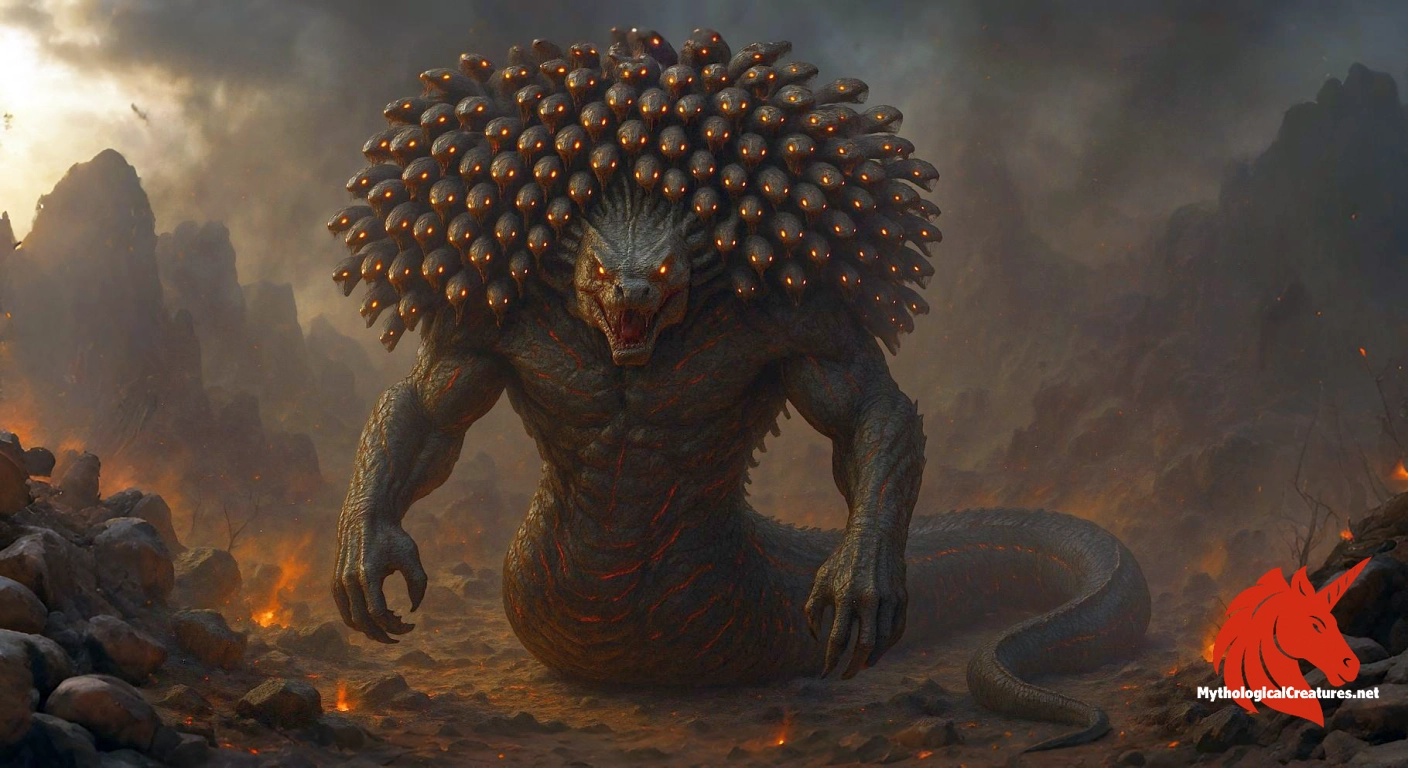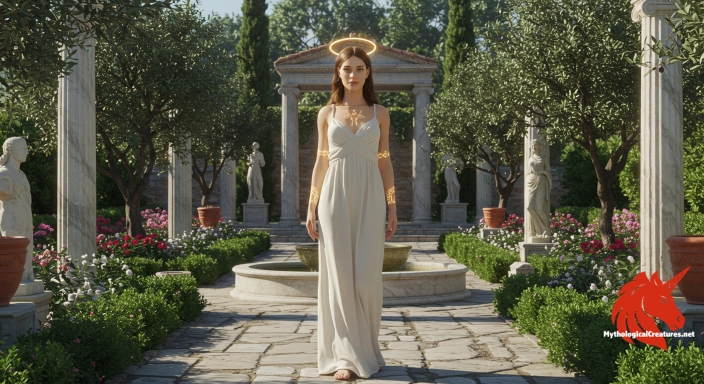Typhon: Typhon is a monstrous serpentine giant from Greek mythology known for his cataclysmic battle against Zeus.

Typhon
Typhon - His battle with Zeus marks the foundation of the current divine order, and his offspring include many legendary monsters.
Origins & First Encounters
Typhon emerges from ancient myth as one of the most formidable creatures, a monstrous force whose very existence embodies chaos and untamed power. He is traditionally hailed as a serpentine giant whose origins are intricately tied to the primordial forces of the earth. Born of Gaia and Tartarus in Hesiod’s accounts, his origins invite interpretations that span various mythic traditions. His emergence in the Greek succession myth marks the dramatic rise of a being whose destiny was to challenge the divine order. In his audacious attempt to overthrow Zeus, Typhon symbolises the eternal struggle between cosmic order and elemental chaos. Tales of his monstrous form and relentless fury resonated deeply with ancient audiences who sought to understand the forces of nature. His narrative, rich with allegory and elemental symbolism, continues to intrigue those with a passion for myth and the mysteries of creation. The sheer magnitude of his myth underscores the cultural importance of personifying natural disasters and cosmic upheaval as living entities. His legacy is not merely confined to myth but continues to influence modern interpretations of chaos versus order. By embodying destructive power and primordial energy, Typhon remains a seminal figure in the study of ancient mythology.
Source Texts & Tale Variants
The stories of Typhon are preserved in a tapestry of ancient texts that offer both consistent and varied portrayals of his nature. Hesiod’s accounts form the cornerstone of his myth, providing the earliest detailed depictions of his origins and cataclysmic battles. Yet, as time passed, other sources introduced alternative genealogies, attributing his birth to figures such as Hera or even Cronus. Various fragments, from lost epic poems to later summarising works, enriched the narrative with subtle differences in detail and emphasis. His tumultuous conflict with Zeus is recounted in multiple literary traditions, each adding layers to the myth’s complexity. In certain local traditions, his defeat is immortalised through associative symbolism with natural landmarks, lending further credence to the myth’s enduring dynamism. The evolution of Typhon’s myth demonstrates the fluidity of oral and written traditions in the ancient world. Diverse authors and regional storytellers contributed unique variations that helped cement his reputation as a primordial adversary. These variants reflect both the adaptability of myth and the universal resonance of his struggle against divine order. Such extensive narrative diversity highlights the enduring fascination with Typhon and the complex interplay of myth and regional belief.
Form & Powers
Typhon is portrayed with an awe-inspiring and terrifying physical form that defies conventional beauty, embodying the very essence of chaotic might. His body is often depicted as a massive serpentine coil, merging elements of a giant with those of a formidable snake, which accentuate his inhuman proportions. Ancient descriptions evoke images of a creature crowned with multiple writhing heads, each pulsating with a feral, untamed energy. His eyes are said to burn like molten coals, reflecting an inner fire and a wrath that could instil dread in the bravest of hearts. Some accounts detail limbs as monstrous and disproportionate, lending an appearance that is both rugged and grotesque. The depiction of Typhon suggests not only a physical manifestation of serpentine terror but also the embodiment of nature’s violent unpredictability. His form is adorned with scales and sinuous curves, creating a tapestry of movement and menace that is as alarming as it is fascinating. In artistic renditions, the interplay of fire and shadow further accentuates his supernatural aura, aligning his image with that of volcanic fury. As descriptions evolved, so too did his attributes, sometimes incorporating wings or additional serpentine features that symbolise his capacity for overwhelming destruction. Each detail of his anatomy contributes to an overall image that is both mythically grand and viscerally terrifying.
Regional Faces
Regional interpretations of Typhon reflect the diverse cultural landscape of ancient myth, where local traditions adapted his story to resonate with their own natural and cultural phenomena. In parts of Greece, he is not only a symbol of cosmic disorder but also a personification of volcanic eruptions and seismic activities. The legends of southern Italy and Sicily connect Typhon with the rumblings of Mount Etna, reinforcing his image as a being tied to the volatile forces of the earth. On the island of Ischia, later accounts suggest that his imprisonment served as an explanation for the island’s mysterious geological features. Regional storytellers often interwove local deities and landscapes with his myth, enhancing his image as a multi-faceted terror. His attributes were occasionally blended with indigenous chthonic deities, echoing local interpretations of power and retribution. Such narratives provided communities with allegories that explained natural disasters and the unpredictable behaviour of the environment. These adaptations underscore not only the fluidity of myth across different regions but also the universal appeal of Typhon’s narrative as a canvas for interpreting nature’s fury. Each regional variant, while rooted in the core myth, offers a unique lens through which to view the interplay of tradition and the natural world. This regional diversity ensures that Typhon remains a dynamic figure whose terrifying presence adapts to various cultural contexts.
Cultural Parallels
Examining Typhon alongside other mythological figures reveals striking parallels in the depiction of chaos and cosmic rebellion. Much like the serpent Jörmungandr in Norse mythology, Typhon represents a force of nature that challenges the established order of the cosmos. His role as a progenitor of monsters aligns him with similar figures in other traditions who give rise to a pantheon of destructive beings. The composite imagery of his serpentine form finds echoes in the struggles against divine order found in Babylonian myths, notably the battle against Tiamat. His character encapsulates the archetypal struggle between creation and destruction, a theme that resonates across various cultural narratives. The association with the Egyptian god Set further underscores how civilizations projected their fears of chaos onto overpowering deities. Typhon’s myth also finds thematic comparison with the primordial struggles of other ancient societies, where deities often battled incarnations of chaos to establish cosmic order. These cross-cultural comparisons enrich our understanding of how ancient peoples rationalised the unpredictable forces of nature. By drawing on universal themes, Typhon’s story underscores a shared mythological language that spans continents. The enduring resonance of such figures reveals the deep psychological and cultural need to symbolise the interplay between divine order and chaos.
Legacy & Modern Evolution
Over the centuries, Typhon’s image has undergone a profound transformation, evolving from a fearsome arbiter of destruction to a symbol rich with modern mythic significance. His original portrayal in ancient texts as a chaotic adversary has been reimagined in various forms of art, literature, and contemporary media. Throughout history, his story has provided fertile ground for artistic expression, often serving as a metaphor for natural disasters and the inherent unpredictability of nature. Modern reinterpretations portray him in graphic novels, films, and video games, where his monstrous form is both a reminder of mythic grandeur and a warning of nature’s untamed power. Academics and enthusiasts alike continue to explore his narrative, unearthing insights into ancient belief systems and the symbolic representation of cosmic struggle. The transformation of Typhon’s myth reflects broader cultural shifts in how society engages with the concepts of chaos and order. His depictions have gradually incorporated modern sensibilities, often highlighting themes of defiance, transformation, and the duality of creation and destruction. As technological advances allow for more vivid visualisations, contemporary artists have reimagined his form with a blend of tradition and innovation. The legacy of Typhon extends beyond classical mythology, influencing discussions about environmental catastrophe and the human confrontation with nature’s extremes. Today, his myth endures as a captivating narrative that continues to inspire, challenge, and provoke thought in an ever-changing cultural landscape.
Interesting Fact
The conflicting accounts of Typhon's parentage and his varied fates in myth highlight the evolving nature of ancient storytelling, where a single figure can embody multiple narratives and cultural significances.
Quick Creature Info
Origin:
Features:
Associations:
Our Mythic Legendary Rating:

Also Sometimes Known As:
Habitat:
Supernatural Powers:
Physical Attributes:
Abilities:
Behavior:
Lore:
References
Discover Another Mythical Legend You May Not Have Heard Of?
Uncover the mysteries of ancient folklore and expand your knowledge of legendary beings from cultures around the world.
Dare to Meet the Peitho....
Mythical Disclaimer: The images and data on this site are derived from various historical and literary sources, but we have found that many myths often have multiple versions and interpretations across references, sometimes contradictory. As a result, these creature depictions are artistic interpretations—imaginative blends of folklore, legend, and a dash of AI guesswork. Because creature descriptions vary widely, our illustrations and accompanying information represent our best effort to honor mythology while bridging creative gaps. Enjoy these interpretations—just remember, we've done our best to respect the stories and validate available data, but in the realm of mythology, details often shift, imagination leads the way, and nothing is ever set in stone!
Curated by the Mythological Creatures Team (rev. May 2025)
